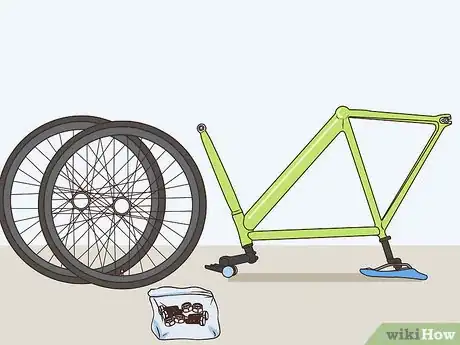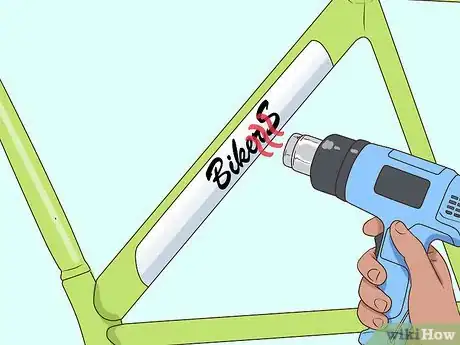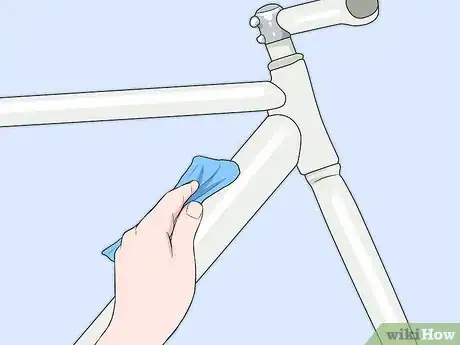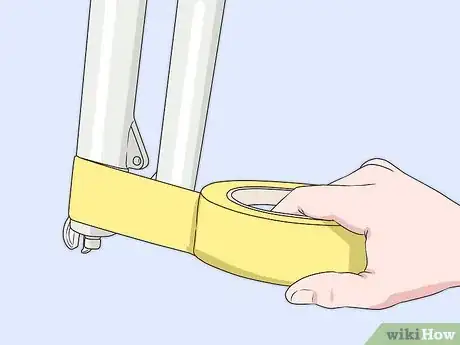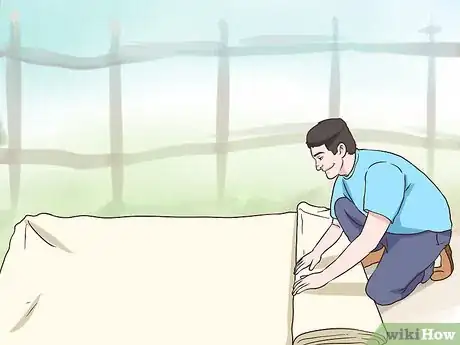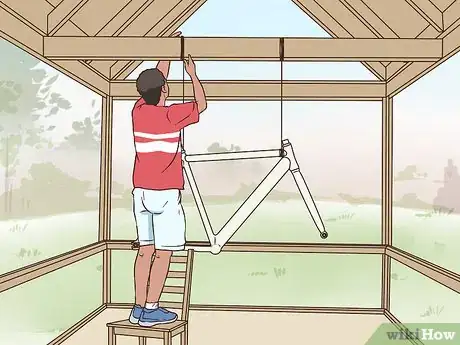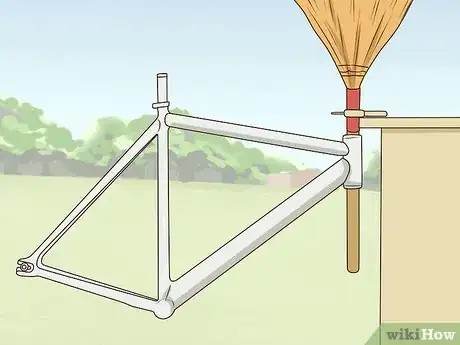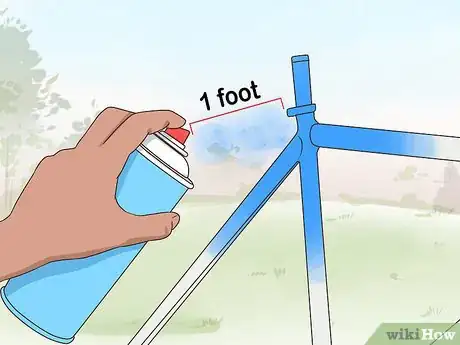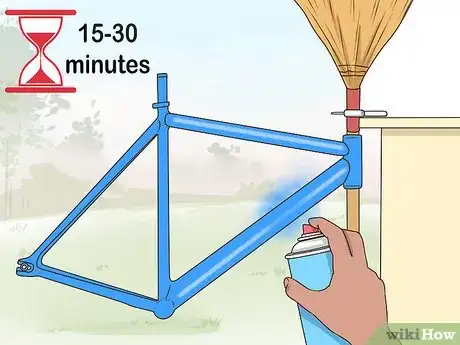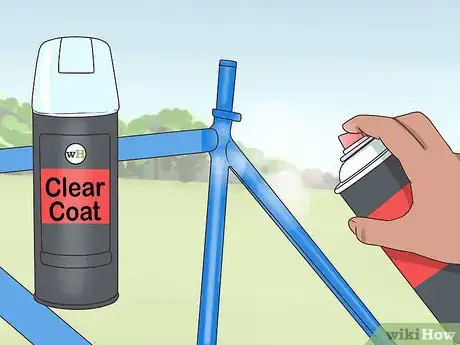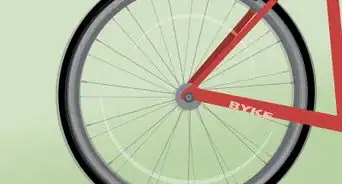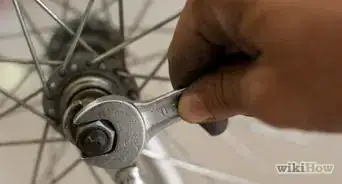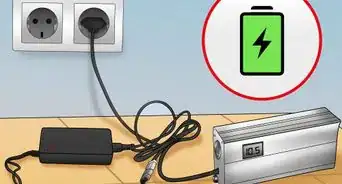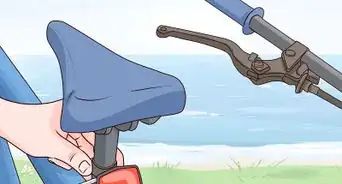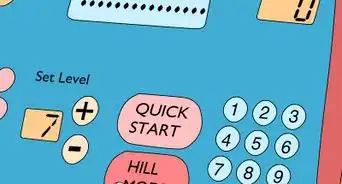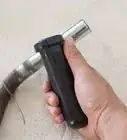This article was co-authored by Patrick Coye and by wikiHow staff writer, Kyle Hall. Patrick Coye is the owner and operator of Patrick’s Painting & Home Improvement in Alexandria, Virginia. With over 15 years of experience in residential construction, Patrick specializes in painting, wallpaper removal/installation, drywall, staining decks and fences, and kitchen cabinetry painting. To date, Patrick and his team have painted over 2,000 houses and stained over 800 decks. Patrick's Company won a "Top Job" award from the American Painting contractor magazine in 2020.
There are 12 references cited in this article, which can be found at the bottom of the page.
wikiHow marks an article as reader-approved once it receives enough positive feedback. This article received 16 testimonials and 97% of readers who voted found it helpful, earning it our reader-approved status.
This article has been viewed 2,198,561 times.
If the paint on a bike is old or chipped, painting over it with a few fresh coats of paint is a great way to give it a brand-new, glossy look. Fortunately, you don’t have to pay a professional to retouch a bike for you. With the right tools and some time on your hands, you can paint a bike that will turn out looking polished and custom made.
Things You Should Know
- Separate the frame from the rest of the bike. Then, wipe down residue left on the bike and sand with 120-grit sandpaper.
- Loop a wire or rope through the bike's head tube and hang your bike from a tree or outdoor banister.
- Paint your bike, holding the can from 1 foot (0.3 m) away. Wait a half hour before applying another coat and continue the process until you're done.
Steps
Disassembling and Prepping the Bike
-
1Disassemble your bike until you’re left with just the frame. Remove both wheels, the left and right cranks, the bottom bracket, the front and rear derailleurs, the chain, the brakes, the handlebars, the seat, and the front forks. If you have any attachments on your bike, like a water bottle holder, take the screws off from those too.[1]
- Put the screws and tiny parts from the bike in labeled plastic baggies so it’s easier to reassemble it later.
-
2Remove any labels or decals from the bike frame. You might have a hard time taking them off if they’re old and really stuck on there. If they won’t peel off, use a blow dryer or heat gun to warm them up. The adhesive on the labels will loosen when it’s warmed, making it easier to remove the labels from the frame.[2]
- If you’re having trouble peeling a label off with your fingers, use a putty knife to lift the edges of the label up off the frame.[3]
Advertisement -
3Wipe down the frame of the bike before you sand it. If there’s any glue residue left over from the decals, spray a product like WD-40 on the frame and wipe off the residue with a cloth.[4]
-
4Sand the frame of the bike so the new coat of paint is able to stick. If the frame has a thick or glossy paint on it, use a low-grit (rough) sandpaper to remove a lot of the old paint. If the frame has a matte paint on it or it’s completely bare, use a high-grit (fine) sandpaper.[5]
-
5Wipe the bike down thoroughly and let it dry. Use a cloth with soapy water.[8]
-
6Apply painter’s tape to the areas of the frame you don’t want to be painted. There are a few parts of the frame that should be left paint-free:[9]
- The posts for the brakes.
- Any bearing surfaces.
- Any threads on the bike where something will need to be screwed in when you reassemble it.
Hanging or Mounting the Frame
-
1Put together a painting station outside. If you can’t work outside, make sure you set up in a well-ventilated area, like a garage with the garage door open. Lay a tarp or newspaper on the ground to catch any paint that drips. You’ll also want to have a pair of safety goggles and a dust mask on hand.[10]
-
2Hang the bike frame by looping wire or rope through the head tube. If you’re painting outside, look for something to hang the wire or rope from, like a tree branch or a rafter on a covered porch. If you’re working inside, hang the wire or rope from the ceiling. The goal is to hang the frame in a location where you can easily walk around it and paint every side.[11]
-
3Mount the frame on a table if you can’t hang it. Put a broomstick or dowel through the head tube and clamp it onto a table so that the frame is securely elevated in the air off to one of the sides of the table.[12]
- If you don’t have a table, you can mount the frame on a desk, stand, or other structure that will hold the bike off the ground.
Painting and Reassembling the Bike
-
1Use a high-quality spray paint to paint the frame. Look online or in your local hardware store for spray paint that is specifically made for use on metal. Avoid generic brands that will leave the coat on the frame looking uneven.[13]
- Never combine different brands of spray paint. The different paints might react badly with each other.[14]
- If you want the bike frame to look matte instead of glossy, look for spray paint that says “matte finish” on the can.
-
2Spray paint the first coat on the bike frame. Hold the can of spray paint around 1 foot (0.3 m) (30.48 cm) away from the frame while you’re spraying it, and keep the can in constant motion. Avoid spraying continuously in one area, or you will end up with drip marks. Make your way around the entire frame until the whole surface has been covered with paint.[15]
- Don’t worry if you still see some of the old paint showing through the first coat. You want to do several thin coats as opposed to one thick coat, so the old paint will be covered up after you apply more coats later on.[16]
-
3Let the first coat dry for 15-30 minutes before you apply the second coat. Once the first coat is completely dry, repeat the spray-painting process, making sure you get another thin, even coat on the frame.[17]
-
4Continue applying coats of paint until the old frame is completely covered. Always wait 15-30 minutes in between coats. The amount of coats you need will depend on the color and type of spray paint you use. When you can’t see the old paint or metal on the frame, and the new paint looks even, you’ve applied enough coats of paint.[18]
-
5Apply a clear coat to protect the bike from rust and keep it looking new. Wait a few hours after spray painting before you apply the clear coat. Once the frame is completely dry, spray an even layer of clear coat all over the bike, similarly to how you applied the spray paint.[19]
- For the best results, apply three coats of clear coat. Let each coat dry for 15-30 minutes before you apply the next one.
- Alternatively, you can use an oxidizing primer made specifically for the metal at the beginning. It will prevent the growth of rust in the future.[20]
-
6Let the bike frame dry for a full 24 hours. Avoid touching or moving the bike during this period. If you painted outside, check the weather forecast and carefully move the bike inside if it’s going to rain or snow. Once it’s completely dry, go ahead and remove any painter’s tape you put on it during the prepping stages.[21]
-
7Reassemble the bike. Put back on all of the parts you detached from the frame earlier, including the wheels, the bottom bracket, the chain, the left and right cranks, the front and rear derailleurs, the handlebars, the brakes, the seat, and the front forks. Now you’re ready to try out your brand-new looking bike![22]
Community Q&A
-
QuestionDo I need to use a primer before painting a bike?
 Alonzo VCommunity AnswerWithout primer, your paint will chip and peel off. The primer bonds the top coat of the bare metal for long-lasting results. I highly recommend using a primer.
Alonzo VCommunity AnswerWithout primer, your paint will chip and peel off. The primer bonds the top coat of the bare metal for long-lasting results. I highly recommend using a primer. -
QuestionWhat brand of primer, paint, and lacquer do you recommend?
 Community AnswerRustoleum is a good brand, but you can also find other quality paints at your local hardware store.
Community AnswerRustoleum is a good brand, but you can also find other quality paints at your local hardware store. -
QuestionCan I apply clear coat paint on the old paint of my bike without sand?
 Community AnswerNo, the new paint won't stick. Sand down the old paint and spray again.
Community AnswerNo, the new paint won't stick. Sand down the old paint and spray again.
Warnings
- Always wear safety goggles and a mask when working with spray paint.[25]⧼thumbs_response⧽
Things You'll Need
- Bike
- Tool kit
- Sandpaper
- Soap
- Cleaning cloth
- Putty knife (optional)
- Hair dryer or heat gun (optional)
- Painter’s tape
- Spray paint
- Clear coat
References
- ↑ https://www.youtube.com/watch?v=antZgmBskMo&feature=youtu.be&t=21
- ↑ https://www.youtube.com/watch?v=iY1iCPCSmH0&feature=youtu.be&t=7
- ↑ https://www.youtube.com/watch?v=antZgmBskMo&feature=youtu.be&t=152
- ↑ http://bmx.transworld.net/features/diy-how-to-paint-a-frame/
- ↑ http://bmx.transworld.net/features/diy-how-to-paint-a-frame/
- ↑ https://www.iqsdirectory.com/articles/brush/wire-brush.html
- ↑ https://www.lowes.com/pd/Warner-Pro-Grip-5-in-1-2-25-in-Paint-Multi-tool/3562072
- ↑ https://www.youtube.com/watch?v=antZgmBskMo&feature=youtu.be&t=341
- ↑ https://www.youtube.com/watch?v=antZgmBskMo&feature=youtu.be&t=354
- ↑ http://bmx.transworld.net/features/diy-how-to-paint-a-frame/
- ↑ http://bmx.transworld.net/features/diy-how-to-paint-a-frame/
- ↑ http://www.bicycling.com/culture/6-things-to-know-before-you-paint-your-bike
- ↑ http://bmx.transworld.net/features/diy-how-to-paint-a-frame/
- ↑ http://www.bicycling.com/culture/6-things-to-know-before-you-paint-your-bike
- ↑ https://www.youtube.com/watch?v=antZgmBskMo&feature=youtu.be&t=441
- ↑ http://bmx.transworld.net/features/diy-how-to-paint-a-frame/
- ↑ http://bmx.transworld.net/features/diy-how-to-paint-a-frame/
- ↑ http://bmx.transworld.net/features/diy-how-to-paint-a-frame/
- ↑ http://bmx.transworld.net/features/diy-how-to-paint-a-frame/
- ↑ https://indigopaints.com/blog/what-is-red-oxide-metal-primer/
- ↑ http://bmx.transworld.net/features/diy-how-to-paint-a-frame/
- ↑ http://bmx.transworld.net/features/diy-how-to-paint-a-frame/
- ↑ http://bmx.transworld.net/features/diy-how-to-paint-a-frame/
- ↑ http://bmx.transworld.net/features/diy-how-to-paint-a-frame/
- ↑ http://www.bbc.co.uk/homes/diy/safety.shtml
About This Article
To paint a bike, start by disassembling it until you're left with just the frame. Then, sand the frame with a low-grit sandpaper, which will help the paint stick. When you're finished, apply painter's tape to any areas of the frame that you don't want to paint. Next, apply several coats of high-quality spray paint to the bike, letting it dry in between coats. Finally, apply a clear coat and let the bike dry for 24 hours before reassembling it. For tips on hanging your bike so it's easier to paint, scroll down!
